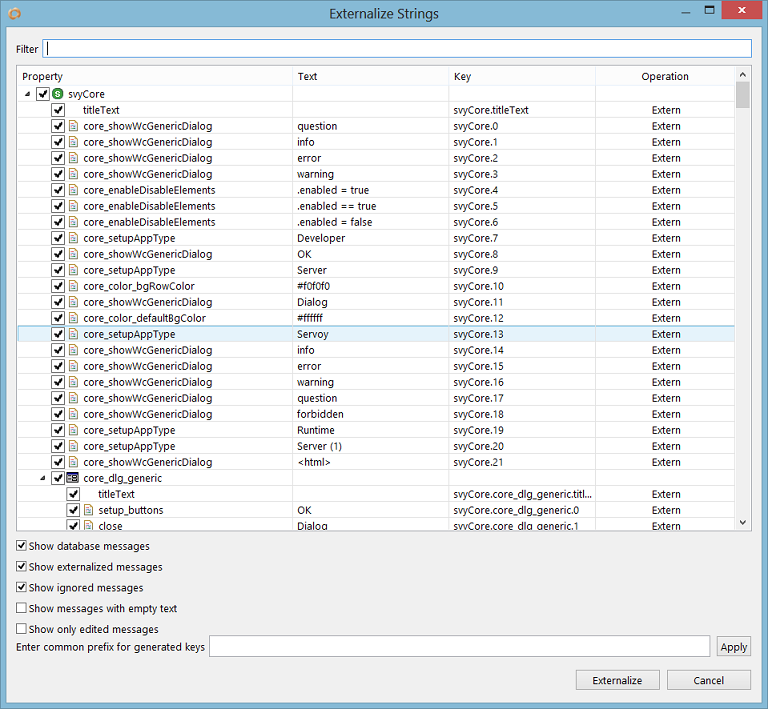Page History
...
The data for internationalization is saved in the workspace under the Resources project. The table is then exported with the solution when the solution is deployed to the application server (if Export i18n data is checked in the Solution Export Wizardwizard).
Defining an i18n Table for a Solution
To add internationalization to a solution, an i18n table needs to be associated with the solution. A message dialog will prompt the developer to do this when first adding internationalization to a solution using either of the two available methods: (1) externalizing all the available text in a solution or (2) adding i18n messages one by one to forms/scripts.
...
To externalize a solution:
- Choose either of the two options: (a) Click on the Externalize Strings button on the toolbar or (b) go to Actions > Show Externalize Strings Dialog.
The i18n externalize dialog box will open, showing the following three columns (from left to right):- The text property to be externalized
- The hardcoded text that will become the default text
- The i18n key name to be assigned to the property
- Customize/edit the keys by double-clicking on a desired key.
- Deselect any items that are not desired to be shown in the list, hence not externalized.
- Enter common prefix for generated keys, if desired. Click Apply for the prefix to be applied on the key values.
- Click Externalize. An externalize dialog will appear, showing the status of the externalize process. Once completed, this dialog disappears and all item properties will be converted to i18n keys.
...
To view and edit an i18n table:
- Choose either of the three options: (a) click on the Edit I18N Messages button on the toolbar or (b) go to Solution Explorer > Resources > I18N files or (c) go to Actions > Show I18N Dialog.
In case of choosing (b) the Solution Explorer, either double click on the node itself or double click on the desired i18n file in the contextual list at the bottom of the Solution Explorer.
The i18n table will be opened in Table Editor view. - Along the top of this view is a filter that enables users to quickly find a i18n key. The next two items at the top are the Language and Country drop-downs. To edit an i18n key:
- Select the key and the language/country to be edited.
- Click on the desired i18n key from the list.
- Enter the reference text (which is the default language text) and the locale text appropriate to that language/country.
- To add a new i18n key:
- Type in a name for the new key in the Key text box.
- Enter the reference text and the locale text in their respective boxes.
- Click Add.
...
- In the Form Editor, simply type in the i18n key where one would normally type in the hardcoded text (for example, inside a text box or label, or via the Properties view in
text,toolTipText, ortitleTextproperties. - In the Script Editor, type in the i18n key inside the string in place of hardcoded text.
Setting I18N Globally
Internationalization can be set globally via preferences.
Go to Window > Preferences > Servoy > Internationalization to set default formats, language, timezone, I18N server and table.
When no i18n table is defined at solution level, the solution will use the global settings. Otherwise, the i18n settings at solution level will override the default preferences.
Importing / Exporting I18N Data
When importing a solution, the Import wizard provides options to import:
- All i18n data
- Only the new i18n language keys
When exporting a solution, the Solution Export wizard provides an option in the Choose export options page to export i18n data.
